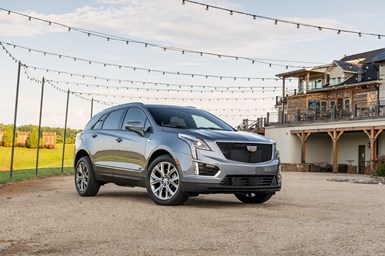J.D. Power Assesses High Tech for Vehicles
The fifth annual U.S. Tech Experience Index Study shows that consumers like cameras but not waving their hands at their instrument panels
#electronics
Kristin Kolodge, executive director of driver interaction & human machine interface research at J.D. Power, undoubtedly made the folks at Cadillac who are deploying advanced tech in the division’s vehicles extremely happy: in the J.D. Power 2020 U.S. Tech Experience Index (TXI) Study results released today, Cadillac was three for three the Advanced Technology Awards:
- Convenience: CT5, rear seat reminder tech
- Emerging automation: Escalade, rear-cross traffic warning (tied with the Genesis G70)
- Infotainment and connectivity: XT5, navigation live traffic
The TXI study is, Kolodge explains, like the J.D. Power Initial Quality Study (IQS) and the J.D. Power Automotive Performance, Execution and Layout (APEAL) Study—and actually the surveyed drivers* had questions for all three on the forms they answered—but it is unlike them, she says, in that it concentrates on “the experiential and the emerging.”

Cadillac XT5: infotainment and connectivity category winner for Premium vehicles in J.D. Power study. (Images: Cadillac)
It is so cutting edge that while there are the three aforementioned category winners, there is actually a fourth category—Energy and Sustainability—that didn’t have sufficient scores to register winners.
It is about high technology being deployed in vehicles—and how well that tech works for the consumer.
“What is the next power window?” she rhetorically asks, pointing out that it is something that few would want to do without. “What is the next powered seatbelt?” she then asks, pointing out that that technology is certainly something no one misses.
The TXI is broken down into two vehicle categories: Premium and Mass Market.
Cadillac’s performance notwithstanding, overall in the Premium category it came in third, with Volvo taking first place and BMW second. In fact, those three are also the top three in the combined Premium/Mass Market assessment.
As for Mass Market, the top three are Hyundai, Subaru and Kia.
In terms of the technology that seems to be most appealing for consumers: “Owners think highly of ‘an extra set of eyes’,” she said, citing such things as camera rear-view mirror systems, ground view cameras, and rear cross-traffic warning systems. (An interesting thing about the camera rear-view mirror system: while it is generally the case that high tech starts on up-grade vehicles and makes its way down to the mass, Kolodge points out that 12% of the Mass Market vehicles have it and just 4% of the Premium.)
In terms of the tech that was thought of the least—so low that on a chart she displays it didn’t make the cut—was interior gesture control. Apparently, the technology performs so abysmally for owners that the gesture most often used is a not-very-nice one.
* The 2020 U.S. Tech Experience Index (TXI) Study is based on responses from 82,527 owners of new 2020 model-year vehicles surveyed after 90 days of ownership. The study was conducted February through May 2020.
RELATED CONTENT
-
Lincoln Corsair Takes Flight
“We wanted to create a dramatic, youthful Lincoln with terrific harmony.” And with the Corsair, they’ve accomplished what they set out to do.
-
2019 Volvo XC40 T5 AWD Momentum and R-Design
Back in 2004, Volvo introduced a concept vehicle, called “Your Concept Vehicle,” in which case the pronoun essentially referred to women because as the company pointed out, the YCC was “the first car designed and developed almost exclusively by women.” Some would say that Volvo was ahead of its time—way ahead—with this idea.
-
Honda Re-Imagines and Re-Engineers the Ridgeline
When Honda announced the first-generation Ridgeline in 2005, it opened the press release describing the vehicle: “The Honda Ridgeline re-defines what a truck can be with its true half-ton bed payload capability, an interior similar to a full-size truck and the exterior length of a compact truck.” And all that said, people simply couldn’t get over the way there is a diagonal piece, a sail-shaped buttress, between the cab and the box.


.jpg;width=70;height=70;mode=crop)